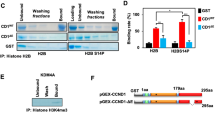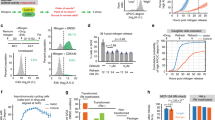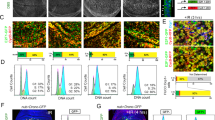Abstract
It is commonly believed that neurons remain in G0 phase of the cell cycle indefinitely. Cell-cycle re-entry, however, is known to contribute to neuronal apoptosis. Moreover, recent evidence demonstrates the expression of cell-cycle proteins in differentiated neurons under physiological conditions. The functional roles of such expression remain unclear. Since DNA repair is generally attenuated by differentiation in most cell types, the cell-cycle-associated events in postmitotic cells may reflect the need to re-enter the cell cycle to activate DNA repair. We show that cyclin-C-directed, pRb-dependent G0 exit activates the non-homologous end joining pathway of DNA repair (NHEJ) in postmitotic neurons. Using RNA interference, we found that abrogation of cyclin-C-mediated exit from G0 compromised DNA repair but did not initiate apoptosis. Forced G1 entry combined with prevention of G1 → S progression triggered NHEJ activation even in the absence of DNA lesions, but did not induce apoptosis in contrast to unrestricted progression through G1 → S. We conclude that G0 → G1 transition is functionally significant for NHEJ repair in postmitotic neurons. These findings reveal the importance of cell-cycle activation for controlling both DNA repair and apoptosis in postmitotic neurons, and underline the particular role of G1 → S progression in apoptotic signaling, providing new insights into the mechanisms of DNA damage response (DDR) in postmitotic neurons.
Similar content being viewed by others
Log in or create a free account to read this content
Gain free access to this article, as well as selected content from this journal and more on nature.com
or
Abbreviations
- CDK:
-
cyclin-dependent kinase
- CKI:
-
cyclin-dependent kinase inhibitor
- DNA–PKcs:
-
DNA–protein-kinase catalytic subunit
- DSB:
-
double-strand break
- NHEJ:
-
non-homologous end joining
- pRb:
-
retinoblastoma protein
- siRNA:
-
small interfering RNA
- DDR:
-
DNA damage response
References
Bassing CH, Alt FW . The cellular response to general and programmed DNA double strand breaks. DNA Repair (Amst) 2004; 3: 781–796.
Lavin MF, Kozlov S . DNA damage-induced signalling in ataxia–telangiectasia and related syndromes. Radiother Oncol 2007; 83: 231–237.
Fishel ML, Vasko MR, Kelley MR . DNA repair in neurons: so if they don't divide what's to repair? Mutat Res 2007; 614: 24–36.
Biton S, Barzilai A, Shiloh Y . The neurological phenotype of ataxia–telangiectasia: solving a persistent puzzle. DNA Repair (Amst) 2008; 7: 1028–1038.
Rhind N, Russell P . Checkpoints: it takes more than time to heal some wounds. Curr Biol 2000; 10: R908–R911.
Schmetsdorf S, Gärtner U, Arendt T . Constitutive expression of functionally active cyclin-dependent kinases and their binding partners suggests noncanonical functions of cell cycle regulators in differentiated neurons. Cereb Cortex 2007; 17: 1821–1829.
Schmetsdorf S, Arnold E, Holzer M, Arendt T, Gärtner U . A putative role for cell cycle-related proteins in microtubule-based neuroplasticity. Eur J Neurosci 2009; 29: 1096–10107.
Becker EB, Bonni A . Cell cycle regulation of neuronal apoptosis in development and disease. Prog Neurobiol 2004; 72: 1–25.
Kruman II, Wersto RP, Cardozo-Pelaez F, Smilenov L, Chan SL, Chrest FJ et al. Cell cycle activation linked to neuronal cell death initiated by DNA damage. Neuron 2004; 41: 549–561.
McMurray CT . To die or not to die: DNA repair in neurons. Mutat Res 2005; 577: 260–274.
Narciso L, Fortini P, Pajalunga D, Franchitto A, Liu P, Degan P et al. Terminally differentiated muscle cells are defective in base excision DNA repair and hypersensitive to oxygen injury. Proc Natl Acad Sci USA 2007; 104: 17010–17015.
Schwartz EI, Smilenov LB, Price MA, Osredkar T, Baker RA, Ghosh S et al. Cell cycle activation in postmitotic neurons is essential for DNA repair. Cell Cycle 2007; 6: 318–329.
Nevins JR . The Rb/E2F pathway and cancer. Hum Mol Genet 2001; 10: 699–703.
Ren S, Rollins BJ . Cyclin C/Cdk3 promotes Rb-dependent G0 exit. Cell 2004; 117: 239–251.
Zhang J, Ghio AJ, Gao M, Wei K, Rosen GD, Upadhyay D . Ambient particulate matter induces alveolar epithelial cell cycle arrest: role of G1 cyclins. FEBS Lett 2007; 581: 5315–5320.
Khanna KK, Jackson SP . DNA double-strand breaks: signaling, repair and the cancer connection. Nat Genet 2001; 27: 247–254.
Yano K, Morotomi-Yano K, Adachi N, Akiyama H . Molecular mechanism of protein assembly on DNA double-strand breaks in the non-homologous end-joining pathway. J Radiat Res (Tokyo) 2009; 50: 97–108.
Lea NC, Orr SJ, Stoeber K, Williams GH, Lam EW, Ibrahim MA et al. Commitment point during G0 → G1 that controls entry into the cell cycle. Mol Cell Biol 2003; 23: 2351–2361.
Grawunder U, Finnie N, Jackson SP, Riwar B, Jessberger R . Expression of DNA-dependent protein kinase holoenzyme upon induction of lymphocyte differentiation and V(D)J recombination. Eur J Biochem 1996; 241: 931–940.
Diggle CP, Bentley J, Kiltie AE . Development of a rapid, small-scale DNA repair assay for use on clinical samples. Nucleic Acids Res 2003; 31: e83.
Chan DW, Chen BP, Prithivirajsingh S, Kurimasa A, Story MD, Qin J et al. Autophosphorylation of the DNA-dependent protein kinase catalytic subunit is required for rejoining of DNA double-strand breaks. Genes Dev 2002; 16: 2333–2338.
Ding Q, Reddy YV, Wang W, Woods T, Douglas P, Ramsden DA et al. Autophosphorylation of the catalytic subunit of the DNA-dependent protein kinase is required for efficient end processing during DNA double-strand break repair. Mol Cell Biol 2003; 23: 5836–5848.
Zhang Y, Qu D, Morris EJ, O’Hare MJ, Callaghan SM, Slack RS et al. The Chk1/Cdc25A pathway as activators of the cell cycle in neuronal death induced by camptothecin. J Neurosci 2006; 26: 8819–8828.
Pajalunga D, Mazzola A, Salzano AM, Biferi MG, De Luca G, Crescenzi M . Critical requirement for cell cycle inhibitors in sustaining nonproliferative states. J Cell Biol 2007; 176: 807–818.
Smith DS, Leone G, DeGregori J, Ahmed MN, Qumsiyeh MB, Nevins JR . Induction of DNA replication in adult rat neurons by deregulation of the retinoblastoma/E2F G1 cell cycle pathway. Cell Growth Differ 2000; 11: 625–633.
Rogoff HA, Kowalik TF . Life, death and E2F: linking proliferation control and DNA damage signaling via E2F1. Cell Cycle 2004; 3: 845–846.
Alvira D, Yeste-Velasco M, Folch J, Casadesús G, Smith MA, Pallàs M et al. Neuroprotective effects of caffeine against complex I inhibition-induced apoptosis are mediated by inhibition of the Atm/p53/E2F-1 path in cerebellar granule neurons. J Neurosci Res 2007; 85: 3079–3088.
O’Hare MJ, Hou ST, Morris EJ, Cregan SP, Xu Q, Slack RS et al. Induction and modulation of cerebellar granule neuron death by E2F-1. J Biol Chem 2000; 275: 25358–25364.
Neve RL, McPhie DL . Dysfunction of amyloid precursor protein signaling in neurons leads to DNA synthesis and apoptosis. Biochim Biophys Acta 2007; 1772: 430–437.
Klein JA, Longo-Guess CM, Rossmann MP, Seburn KL, Hurd RE, Frankel WN et al. The harlequin mouse mutation downregulates apoptosis-inducing factor. Nature 2002; 419: 367–374.
Kuan CY, Schloemer AJ, Lu A, Burns KA, Weng WL, Williams MT et al. Hypoxia-ischemia induces DNA synthesis without cell proliferation in dying neurons in adult rodent brain. J Neurosci 2004; 24: 10763–10772.
Höglinger GU, Breunig JJ, Depboylu C, Rouaux C, Michel PP, Alvarez-Fischer D et al. The pRb/E2F cell-cycle pathway mediates cell death in Parkinson's disease. Proc Natl Acad Sci USA 2007; 104: 3585–3590.
Ruzankina Y, Asare A, Brown EJ . Replicative stress, stem cells and aging. Mech Ageing Dev 2008; 129: 460–466.
Roos WP, Kaina B . DNA damage-induced cell death by apoptosis. Trends Mol Med 2006; 12: 440–450.
Copani A, Sortino MA, Caricasole A, Chiechio S, Chisari M, Battaglia G et al. Erratic expression of DNA polymerases by beta-amyloid causes neuronal death. FASEB J 2002; 16: 2006–2008.
Shiloh Y . The ATM-mediated DNA-damage response: taking shape. Trends Biochem Sci 2006; 31: 402–410.
Downs JA, Jackson SP . A means to a DNA end: the many roles of Ku. Nat Rev Mol Cell Bio 2004; 5: 367–378.
Rampakakis E, Di Paola D, Zannis-Hadjopoulos M . Ku is involved in cell growth, DNA replication and G1 → S transition. J Cell Sci 2008; 121: 590–600.
Sharma S . Age-related nonhomologous end joining activity in rat neurons. Brain Res Bull 2007; 73: 48–54.
Hyslop PA, Zhang Z, Pearson DV, Phebus LA . Measurement of striatal H2O2 by microdialysis following global forebrain ischemia and reperfusion in the rat: correlation with the cytotoxic potential of H2O2 in vitro. Brain Res 1995; 671: 181–186.
Acknowledgements
We thank Raul Perez-Olle for helpful discussions and P Makhov for the pGL3 basic vector. This work was supported by the Garrison Institute on Aging, TTUHSC. MG was funded by the NIA-IRP, NIH.
Author information
Authors and Affiliations
Corresponding author
Ethics declarations
Competing interests
The authors declare no conflict of interest.
Additional information
Edited by N Bazan
Rights and permissions
About this article
Cite this article
Tomashevski, A., Webster, D., Grammas, P. et al. Cyclin-C-dependent cell-cycle entry is required for activation of non-homologous end joining DNA repair in postmitotic neurons. Cell Death Differ 17, 1189–1198 (2010). https://doi.org/10.1038/cdd.2009.221
Received:
Revised:
Accepted:
Published:
Issue date:
DOI: https://doi.org/10.1038/cdd.2009.221
Keywords
This article is cited by
-
Failure of DNA double-strand break repair by tau mediates Alzheimer’s disease pathology in vitro
Communications Biology (2022)
-
Core cell cycle machinery is crucially involved in both life and death of post-mitotic neurons
Cellular and Molecular Life Sciences (2020)
-
Context-Dependent Functions of E2F1: Cell Cycle, Cell Death, and DNA Damage Repair in Cortical Neurons
Molecular Neurobiology (2020)
-
Genomic integrity and the ageing brain
Nature Reviews Neuroscience (2015)
-
Physiological and pathophysiological functions of cell cycle proteins in post-mitotic neurons: implications for Alzheimer’s disease
Acta Neuropathologica (2015)



